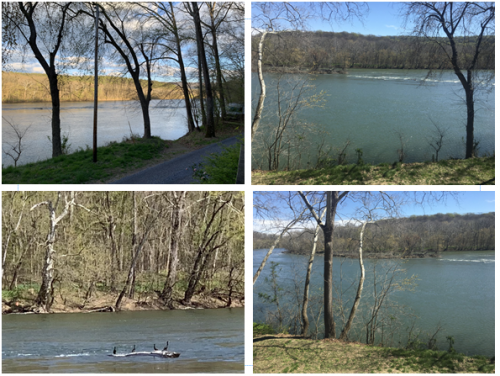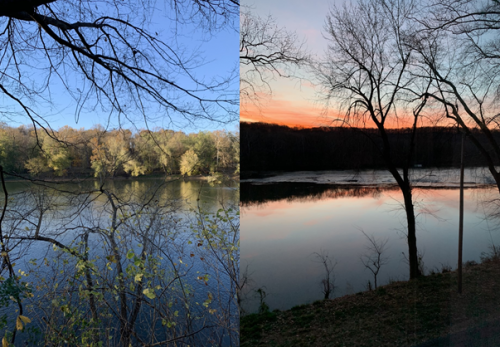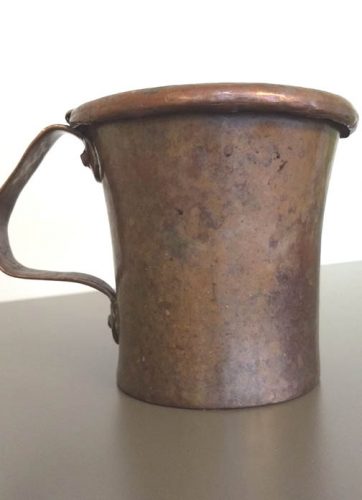Exploring History at Home

JMM Volunteers Share Stories
If you find yourself on the main page of JMM’s website, you will read two short sentences that we often use to introduce ourselves: “At JMM, we are storytellers. We’re also storyfinders, storykeepers, and storyprotectors.”
While we are staying home to stay safe, JMM is still committed to sharing stories. Stories of Jewish experiences and stories that connect Jewish Marylander’s to their roots. During a time when you aren’t able to visit the Museum and experience these stories in person, our team has been working hard to bring stories into your homes.
Our passionate volunteers have continued to act as storytellers (I recommend joining them on a tour of the Lloyd Street Synagogue in the future). We recently asked our volunteers to share a photo of an object in their home and to tell us about it. Without hesitation, they have welcomed us into their homes to share the stories behind some of their most meaningful objects.
I have enjoyed reading these short stories, learning more about our JMM family, and am honored to share some of them here. I hope these encourage you to explore history in your home, look at your possessions in a new way, and think about the stories you can share.
~Paige Woodhouse, School Program Coordinator
To read more posts from Paige, click here!

One way I’ve been keeping busy during the coronavirus quarantine is by cleaning. My husband and I have tackled our crawl space, numerous closets and drawers. I suspect many others have as well. In going through our many boxes of keepsakes, I came across these dolls that were given to me as a child, but for which I had no recollection. Included with the dolls was a note from my first cousin telling me the dolls were all that was left of our great aunt Sabine Schneebalg from Nuremberg, Germany. Her husband and two sons were rounded up from their home by the SS and sent to concentration camps where they perished. Sabine was physically disabled, so the Nazis left her alone in the house where it is presumed she starved to death. No neighbors dared to assist her in anyway.
My cousin says Sabine was a beautiful, artistic woman. The clothing on the dolls was hand knitted by her. The dolls were given to my cousin 85 years ago. She had subsequently passed them down to me, with the hope that I would treasure them and then pass them down to my daughter. I plan to do that once I am able to see my daughter in person. I also plan to have their arms reattached if I can find a doll hospital that is able to do so.
What a special find that probably would have gone undetected if it had not been for the coronavirus!
~Nancy Kutler

It was given to her by a rabbi, possibly her father, at a time when she must have been very ill. The amulet, or Kamaiyah (Yiddish), was supposed to shield her from harm. She wore it pinned to her undergarments for her entire life. It was encased in a lead tube covered with linen.
The text invokes various names of God and angels. Notice that it is a “fill in the blanks” piece, because the rabbi scribed a few at a time to keep on hand for sick people and then simply filled in the appropriate name in quick script.
Amulets are very rarely seen today, and I believe this is quite rare. My grandmother’s family lived in what is now the Ukraine for well over 400 years, and this custom is no longer practiced except perhaps in some very tiny Chasidic communities.
~Joyce Jandorf, Volunteer

In 1985, before cell phones and the internet, my husband’s position changed and we would no longer be able to do our very rural Vermont camping where there were no roads, no electricity nor water. It was a place in the woods that we loved where we set up our own camp, bathed in the lake with biodegradable soap, and trekked in everything we needed.
Because he had to be closer to work we decided to purchase a house where we could more easily get away. My husband purchased a West Virginia canoe map and calculated what would be no more than one and a half hours away. He then looked at what touched on water and contacted a real estate agent to show us some properties in the areas he identified.
When we met with the real estate agent, she told us she had identified another house which didn’t meet all the requirements he stipulated, but thought we might want to look at it. He was reluctant, but I agreed. She took us there first.
The house, down a private road with about 8 other rather tacky houses to the right and water to the left was even worse than any of the other tacky houses we saw. Its floors were rotted, the opaque windows were tiny and the interior, as my husband said, “looked like the inside of a van conversion.” The agent informed us that the body of water that wasn’t visible through the scratched plastic windows was the Potomac River and beyond that was the C&O Canal, protected land.

The agent got into her car, we got into ours to follow her to the other properties she was to show us and I said to my husband, “We’re buying this.” My husband incredulously said, “Are you crazy? It’s horrible.” I agreed and added, “while the house is horrible we can change that, but the view is amazing and it will never change.” And off we went to see the other identified properties.
One of the properties must have been used to film the movie, Deliverance. Another required walking past a trailer park to get to the water and the last one was on a lot that had every tree cut down. To see the Opequon Creek you had to stand over the dried up creek, except when it flooded we were told, and the view on the other side of the creek was of a house on land as barren as this piece of land. In other words, there was no view. So we asked to look at the first house again.
After we purchased this horrible house, the agent told us that the owner did van conversions. We laughed. We didn’t laugh when we drove down the road and we stopped to greet our next door neighbor who was carrying a shotgun and said, “Some Jews bought that house (he knew it was us), but I guess it’s ok since he’s a doctor.” Over a very short time he became our security system as he looked over our house and if anyone went there he made sure they belonged there. He and all of the other neighbors have been super.
Immediately after moving in, we put in large windows looking out at the river and the trees beyond- the view which I said would never change. Also, we built a shed which blocked our view from the houses, so we had privacy, and put up a large screened porch between the shed and the house. Then we decided to live with it for a little while to clarify what we wanted. Eventually we totally redid the house. It is even more beautiful than I could have imagined. However, each time I call my husband to see something of beauty on the river or the trees of the C&O Canal, he reminds me how much the view changes.
As we’ve been here over the past month, isolating from COVID 19, we have watched the trees go from barren to bud to fully unfurled leaves, from light green to deep green, yellow, or red depending on the type of tree. The water level rises and falls so sometimes the rocks at the waterfall are exposed and the birds are sitting on them while at other times the rocks are completely submerged in the water which sometimes moves swiftly and sometimes more slowly. The ducks or geese may be playing in the water or flying overhead, or parading in front of our house to show off their new ducklings or goslings.
It’s a view that never changes but always does.
~Helene G.

My grandfather, Rabbi Joshua Klavan z”l’s washing cup is made of copper, a bit of brass, and lined with lead. About 50 years ago, I found it in my uncle’s garage filled with rusty nails and showed it to my father. He was surprised to see it, and told me he remembered it from his childhood in Lithuania, where the family lived until he was about 11yrs. old before coming to America in 1923. He recalled using the cup for hand washing before meals, and how he would accompany his father to a tinsmith to patch holes that would appear in it periodically. So I “rescued” that cup from obscurity in the garage, and today it is a family heirloom, probably the only remaining object that belonged to my grandparents.
~Joyce Jandorf, Volunteer

1 reply on “Exploring History at Home”
I am touched by these beautiful stories and how eloquently they are told. They reflect the thoughtfulness of their authors.